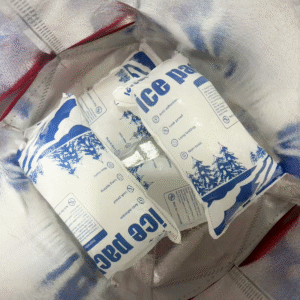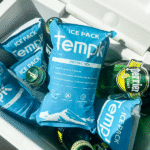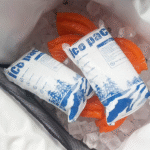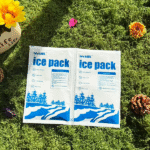Empacar la leche materna con hielo seco asegura un transporte seguro a larga distancia mientras mantiene la leche congelada. Ya sea que sea un padre que viaja o envíe leche materna, El uso de hielo seco proporciona una solución efectiva para preservar la frescura. En esta guía, Desglosaremos todo lo que necesita saber sobre el empacar leche materna con hielo seco de manera segura y eficiente.
-
¿Por qué usar hielo seco para el transporte de leche materna??
-
Cómo empacar leche materna con hielo seco paso a paso?
-
Precauciones de seguridad para manejar hielo seco
-
2025 trends in cold chain packaging for breast milk
Why Use Dry Ice for Breast Milk Transportation?
El hielo seco es la opción preferida para enviar leche materna a largas distancias debido a su temperatura extremadamente baja, que mantiene la leche congelada más larga que los paquetes regulares de hielo o gel. A diferencia del hielo tradicional, que se derrite y crea agua, El hielo seco se sublima de sólido a gas, No dejando residuos. Esta propiedad ayuda a evitar que la leche se descongele o se moje., Preservar sus nutrientes durante el tránsito.
Expert Tip: Dry ice is most suitable for trips lasting over 12 horas, ensuring the milk remains frozen without the need for refills.
Hielo seco vs. Paquetes de gel: cual es mejor?
| Método de enfriamiento | Aproximadamente. Duración | Precauciones de manejo | Lo que significa para ti |
|---|---|---|---|
| Hielo seco | 24-48 horas | Use guantes aislados, store in ventilated containers | Best for long travels |
| Paquetes de hielo en gel | Arriba a 24 horas | Seguro para manejar, easy to replenish | Suitable for short trips |
| Hielo regular | 12-24 horas | Can cause melting and mess | Inconsistent for shipping |
Resumen: Dry ice is essential for long-distance travel or shipping, while gel packs suffice for short trips.
Step-by-Step Guide to Packing Breast Milk with Dry Ice
1. Freeze the Milk Properly
Ensure that the milk is fully frozen before packing. Use durable breast milk storage bags or bottles, leaving space at the top for expansion as the milk freezes.
2. Elija el refrigerador correcto
An insulated cooler, preferably made of Styrofoam or vacuum-insulated material, will help maintain the desired temperature. Avoid using regular picnic coolers as they may not provide adequate insulation.
3. Layer the Milk and Dry Ice
Place a layer of dry ice at the bottom of the cooler. Entonces, place the frozen milk containers on top of the dry ice, ensuring there is a barrier (like newspaper) between the dry ice and the milk to prevent direct contact. Repeat the process, alternating layers of milk and dry ice.
4. Seal and Ventilate the Cooler
Close the cooler tightly but leave a small gap or use a vented cooler to allow the carbon dioxide gas to escape as the dry ice sublimates.
Consejo: Always label the cooler with “Dry Ice UN 1845” and include the net weight of the dry ice, as required by airline and shipping regulations.
5. Select Shipping Method
For the safest transportation, use expedited services like overnight or 2-day shipping. Avoid shipping over the weekend to prevent extended transit times.
How Long Will Dry Ice Keep Breast Milk Frozen?
The duration that dry ice will keep breast milk frozen depends on the amount of dry ice used and the external temperature. Aquí hay algunas pautas generales:
-
5-10 libras de hielo seco will keep milk frozen for 24-36 horas.
-
10-20 libras de hielo seco can keep the milk frozen for 48 horas o más.
Expert Tip: Estimate your travel time and adjust the amount of dry ice accordingly. More dry ice may be needed for longer trips or warmer climates.
Common Mistakes to Avoid When Packing Breast Milk with Dry Ice
-
Not Ventilating the Cooler Properly
Ensure there is enough ventilation to allow the carbon dioxide gas to escape. Sin ventilación, the cooler can rupture. -
Usar muy poco hielo seco
Underestimating the amount of dry ice needed could cause the milk to thaw prematurely. Always calculate the required dry ice based on travel time. -
Packing Milk in Glass Containers
Glass can crack under the extreme cold of dry ice. Stick to plastic or purpose-built storage bags.
2025 Trends in Dry Ice for Breast Milk Transport
A medida que avanza la industria de la cadena de frío, new materials and technologies have emerged to improve breast milk transportation:
-
Aislamiento ecológico: Biodegradable materials are now used to improve the sustainability of dry ice transportation.
-
Monitoreo de temperatura inteligente: Advanced temperature sensors, integrated into shipping containers, allow real-time tracking of conditions during transit, ensuring milk stays frozen.
-
Captured CO₂ Dry Ice: En 2025, dry ice made from captured carbon dioxide is becoming popular as a more eco-friendly option.
Preguntas frecuentes: Common Questions About Packing Breast Milk with Dry Ice
Q1: How much dry ice do I need for a 24-hour shipping time?
Utilice aproximadamente 5-10 libras de hielo seco para 24-36 horas de tiempo de envío.
Q2: Can I use gel packs instead of dry ice?
Gel packs are useful for short trips but cannot maintain the freezing temperatures required for long-distance breast milk transport.
Q3: ¿Cómo estoy dispuesto a sobrantes de hielo seco??
Allow dry ice to sublimate outdoors in a well-ventilated area. Never dispose of it in sinks or toilets.
Conclusión & Recomendaciones
Packing breast milk with dry ice is the safest way to ensure it stays frozen during long-distance transport. By following the steps and safety guidelines outlined in this guide, you can confidently ship your milk to its destination. Remember to estimate the amount of dry ice needed, choose the right cooler, y asegurar una ventilación adecuada.
Siguientes pasos:
-
Select the appropriate cooler and dry ice.
-
Pack the milk in leak-proof, frozen containers.
-
Use expedited shipping for faster delivery.
-
Follow safety protocols when handling dry ice.























